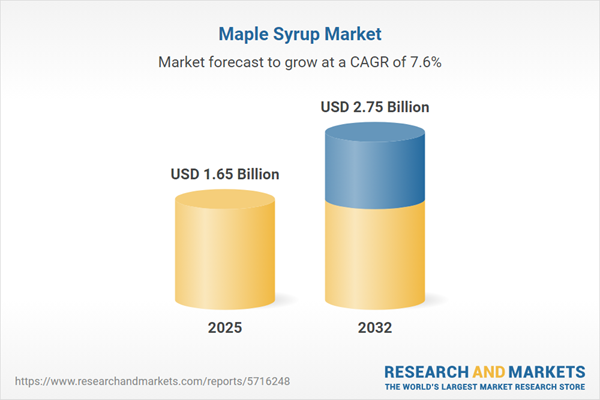Speak directly to the analyst to clarify any post sales queries you may have.
The maple syrup market is experiencing sustained growth, shaped by innovation in production methods, evolving global tastes, and changing trade dynamics. Industry leaders navigating this space must balance heritage with agility to capture emerging opportunities.
Market Snapshot: Global Maple Syrup Market Overview
The maple syrup market grew from USD 1.53 billion in 2024 to USD 1.65 billion in 2025. It is projected to expand at a CAGR of 7.64%, reaching USD 2.75 billion by 2032. This indicates enduring consumer interest and strong fundamentals across regional and segmental lines, driven by product innovation, value chain improvements, and increased health consciousness among end-users.
Scope & Segmentation: Strategic Depth Across Product Types, Channels, and Regions
- Type: Flavored Syrup, Pure Maple Syrup
- Nature: Conventional, Organic
- Grade: Amber Rich, Dark Robust, Golden Delicate, Very Dark Strong
- Channel: Convenience Store, Foodservice (Cafes, Hotels, Restaurants), Online Store, Specialty Store, Supermarket Hypermarket
- Application: Baking Ingredient, Beverage Additive, Breakfast Topping, Confectionery Ingredient
- Packaging: Glass Bottle (100ml, 1L, 250ml, 500ml), Plastic Bottle (1L, 250ml, 2L, 500ml), Pouch (1L, 2L)
- Region: Americas (North America: United States, Canada, Mexico; Latin America: Brazil, Argentina, Chile, Colombia, Peru), Europe, Middle East & Africa (Europe: United Kingdom, Germany, France, Russia, Italy, Spain, Netherlands, Sweden, Poland, Switzerland; Middle East: United Arab Emirates, Saudi Arabia, Qatar, Turkey, Israel; Africa: South Africa, Nigeria, Egypt, Kenya), Asia-Pacific (China, India, Japan, Australia, South Korea, Indonesia, Thailand, Malaysia, Singapore, Taiwan)
- Key Companies: Coombs Family Farms LLC, The J.M. Smucker Company, Maple Grove Farms of Vermont LLC, D.F. Nickerson & Company LLC, TreeHouse Foods Inc., Hain Celestial Group Inc., Northland Organic Foods Corporation, Crosby Molasses Company LLC, Woods & Waters Marketing LLC, Clarks Maple Syrup Company Inc.
Key Takeaways for Senior Decision-Makers
- Production is modernizing, with precision tapping and digital monitoring becoming standard to improve operational efficiency and product traceability.
- Growth in organic and artisanal maple syrup segments demonstrates consumer preference for ecological certifications and unique flavor profiles, especially among health and wellness-focused buyers.
- Regional markets reflect diverse drivers: North America maintains strong heritage consumption, Europe and the Middle East demand premium, sustainable variants, and Asia-Pacific exhibits rising interest in both traditional and blended products through digital retail.
- Strategic collaborations across the foodservice, ingredient manufacturing, and wellness sectors have expanded maple syrup’s presence into adjacent categories such as beverages and gourmet condiments.
- E-commerce has empowered smaller producers to compete globally, matching large legacy brands in both reach and consumer engagement, while also accelerating innovative packaging and direct-to-consumer offerings.
Tariff Impact on Maple Syrup Market Access and Trade Structures
The 2025 introduction of new United States tariffs altered trade conditions for both international suppliers and domestic distributors. Supply chain actors have re-evaluated sourcing and inventory strategies to sustain competitiveness, seeking alternative suppliers and optimizing contract negotiations to mitigate risk from increased duties. These moves have reinforced the importance of agile procurement and intensified investments in compliance and trade analytics.
Methodology & Data Sources
This report integrates primary interviews with industry stakeholders, including producers, distributors, and culinary authorities, to derive qualitative insights on operational and innovation trends. Secondary research draws from published industry materials, regulatory filings, and peer-reviewed academic analysis. Rigorous data validation and cross-referencing protocols ensure accuracy throughout the findings.
Why This Report Matters for Maple Syrup Market Leaders
- Enables executive decision-makers to benchmark strategic investments in technology, sustainability, and market development against top-performing peers.
- Offers an actionable roadmap for optimizing regional market entry, procurement agility, and direct-to-consumer initiatives in an evolving global landscape.
Conclusion
This report offers senior decision-makers a clear, actionable view of changing dynamics in the global maple syrup market. Emerging trends and strategic imperatives are outlined to support confident, future-oriented decisions across product, trade, and regional growth initiatives.
Additional Product Information:
- Purchase of this report includes 1 year online access with quarterly updates.
- This report can be updated on request. Please contact our Customer Experience team using the Ask a Question widget on our website.
Table of Contents
3. Executive Summary
4. Market Overview
7. Cumulative Impact of Artificial Intelligence 2025
Companies Mentioned
The companies profiled in this Maple Syrup market report include:- Coombs Family Farms LLC
- The J.M. Smucker Company
- Maple Grove Farms of Vermont, LLC
- D.F. Nickerson & Company LLC
- TreeHouse Foods, Inc.
- Hain Celestial Group, Inc.
- Northland Organic Foods Corporation
- Crosby Molasses Company, LLC
- Woods & Waters Marketing LLC
- Clarks Maple Syrup Company, Inc.
Table Information
| Report Attribute | Details |
|---|---|
| No. of Pages | 197 |
| Published | November 2025 |
| Forecast Period | 2025 - 2032 |
| Estimated Market Value ( USD | $ 1.65 Billion |
| Forecasted Market Value ( USD | $ 2.75 Billion |
| Compound Annual Growth Rate | 7.6% |
| Regions Covered | Global |
| No. of Companies Mentioned | 11 |









